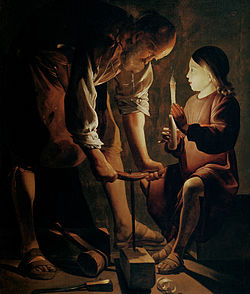This article needs additional citations for verification .(June 2025) |

An auger is a device to drill wood or other materials, consisting of a rotating metal shaft with a blade at the end that scrapes or cuts the wood. [1]
This article needs additional citations for verification .(June 2025) |

An auger is a device to drill wood or other materials, consisting of a rotating metal shaft with a blade at the end that scrapes or cuts the wood. [1]


The classical design has a helical screw blade winding around the bottom end of the shaft. The lower edge of the blade is sharpened and scrapes the wood; the rest of the blade lifts the chips out of the way. It is powered with two hands, by a T-shaped handle attached to the top of the shaft.
More modern versions have elaborated auger bits with multiple blades in various positions. [2] Modern versions also have different means to drive the shaft, resulting in various tools such as braces, wheel drills (the "eggbeater" drill), and power drills.